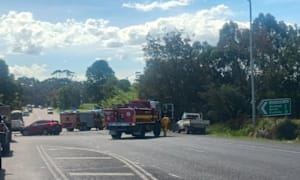CENTENARIAN Bruce Crowl is a familiar face around Corner Inlet. From his residence in Foster right through to his work with Welshpool and District Horticultural Society, he’s a local legend.
Ahead of Remembrance Day, the Sentinel-Times caught up with Mr Crowl to discuss his time on the “lucky ship”.
“I had an appalling year at Swinburne,” Mr Crowl explained.
Keen on attending Melbourne Tech’s Art School, Mr Crowl’s plans were halted when his father promptly enrolled him at Swinburne’s School of Engineering after secondary school, believing that those who fared the best in difficult times were well-educated engineers.
“All the young, proper teachers had gone off to war, and the principal at Swinburne had stepped back down to a teaching role. In 1940, he was still dressing like a Victorian dandy, and his outlook was pretty much the same… His teaching method was sarcasm, and I couldn’t handle it, so I did very poorly.”
In 1943, aged just 17, Mr Crowl joined the Navy.
“I thought the Navy would always have a dry bed, and I wouldn’t have to cook my meals,” he recalled with a smile.
“Their system was to train us leading up to age 18. They recruited us in May, then by September, I was 18 and off to join the ship.”
Mr Crowl was posted to HMAS Australia as a visual signalman.
“Except in action stations, we always had three good meals a day – during action stations, they’d have to douse their fires, so we finished up eating bully beef sandwiches.”
One could only feel for the cooks making enough bread for 1000 men three times a day.
There was no walking away from action stations for a nap either.
“You wouldn’t go back to your hammocks. You just put your head down at your action station. We were aware of the danger of attack from the air at any time, day or night. At one point, we were at action stations for four days continuously. We were able to pull a few old signal flags out of the lockers to soften the steel decks (to sleep on).”
Most of the action during Mr Crowl’s service was during the day.
“There was some naval action at nighttime, but it didn’t suit the aircraft to fly at night.”
Mr Crowl journeyed on HMAS Australia as part of the World War II campaigns in the South Pacific and Philippines.
Having recently recalled the Battle of Leyte Gulf in October 1944 (which can be viewed in Prom Coast News), Mr Crowl took the opportunity to discuss the invasion of the Lingayan Gulf.
Repaired by an American forward engineering base in Espiritu Santo after a kamikaze attack during the Battle of Leyte, HMAS Australia was absorbed into Task Group 77.2.
“We went up to Manus (after repairs), where we stored up again for fuel, food, ammunition and crew.
“We needed 40 or 50 new crew, and we’d given all our shells to the Shropshire when we left after we’d been hit (in Leyte).
“December 15, 1944, an Australian store ship came up with mail and Christmas goodies. The navy was always good about giving us Christmas where they could, so they came with stuffed turkey, roast potatoes, Christmas pudding and a bottle of beer – a cold long neck bottle of beer for every man on the ship.”
After Christmas, it was back to duty, and the focus shifted to the Lingayan Gulf.
“We joined a convoy of 672 ships spanning 65 kilometres; it was an amazing sight,” Mr Crowl said.
“Sixty-five kilometres is from Foster to Inverloch – it was ships to the horizon, not one ship in a straight line.
“We left on the third of January, and on the fourth, the ship beside us took a kamikaze, and then the next day we took one, and lost 29 dead, and 39 wounded.
“The next day, we took another one.
“We had a day off, and that day was spent training up new gunners. We’d lost main deck gunner crews, and they called for volunteers from writers and bandsmen, and anybody who wasn’t having an active role in the fighting. They called them chief gunnery petty officers.
“They finished up, and instead of having four sets of twin guns; we were able to mount two, which was a help.
“Then we had another early morning and another plane hit us on the side of the bridge, no casualties, and we were cleaning up that mess.
“Another one hit us on the water line, and the shell exploded. There was a hole you could have driven a truck through, no casualties – we were lucky.”
Following the kamikaze attack, the ship had to tilt to lift the newly formed hole out of the water, and they temporarily made repairs.
The next day was invasion day; HMAS Australia had made it.
Their initial duty was to bombard the shore and make it easier for the soldiers who would be landing on the beach.
“While that is all happening, we took another kamikaze. They always aim for the bridge. He clipped the mast, fell on top of the front funnel, chopped it in half, and dropped a whole lot of debris down the funnel. That stopped the air ventilation from going down into the engine room, and we had to reduce power.
“By that day, we finished off with a ship that only has half its deck armament working, has a hole in the ship’s side, and we’ve had to reduce engine power because of the debris down the funnel, including the pilot of the suicide plane.
“By then they decided we’d had enough, and that night, half past nine, we left and headed back to Leyte again in a small convoy of empty troop ships and damaged ships.”
Though Mr Crowl deemed HMAS Australia the “lucky ship” for surviving everything thrown at her, when asked why they were targeted, he exclaimed, “We would like to know the answer!”
“There were 672 ships there, there was even another ship, Shropshire, that looked just like us, but why we were picked out one after the other, I’ve got no idea!”
According to Mr Crowl, the suicide bombers were a pest, more than anything.
“We were still able to carry out work; there were some ships sunk by suicide bombers, but they really weren’t having the greatest influence. If they’d been torpedo bombers, that would be a different story altogether.
“The sad thing is, of course, that those young Japanese fellas flying the planes had been brainwashed into believing they were going to Nirvana, and they were filled up with God knows what. That was very demoralising.
“In a normal attack, a plane would line up its target, come in, drop a couple of bricks, and pull off again, and fly back to the airport – have a G&T in the bar with their mates before they go to the mess for dinner. Not the Japanese. They didn’t pull out, they kept on coming and very often the pilot is dead before he ever hits the ship – the plane is just an uncontrolled missile.
“They’re flying through a rain of shells. I remember seeing a piece of wing that was left by one of the planes on our ship, about the size of a table. You could have drawn a two-inch mesh across it all the way, and there would have been a shell hole of some sort in every one of those squares.”
Mr Crowl estimates that half the men on board HMAS Australia were young, all around 19 years old, and noted his experience in the Navy was a good experience.
“It took you out of a square box,” he explained.
“However, war is a terrible thing, it’s awful business, and I don’t believe we need to go.”
Mr Crowl is amongst the lucky ones, he returned home and after finishing his service started a career in the arts, which saw him announce and perform on radio, and on stage across Australia, and even to this day his theatrical roots are very much alive performing in the stage play, Dinner for One with FAMDA.












